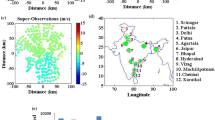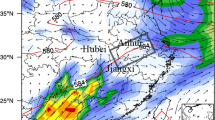Abstract
Different choices of control variables in variational assimilation can bring about different influences on the analyzed atmospheric state. Based on the WRF model’s three-dimensional variational assimilation system, this study compares the behavior of two momentum control variable options—streamfunction velocity potential (ψ–χ) and horizontal wind components (U–V)—in radar wind data assimilation for a squall line case that occurred in Jiangsu Province on 24 August 2014. The wind increment from the single observation test shows that the ψ–χ control variable scheme produces negative increments in the neighborhood around the observation point because streamfunction and velocity potential preserve integrals of velocity. On the contrary, the U–V control variable scheme objectively reflects the information of the observation itself. Furthermore, radial velocity data from 17 Doppler radars in eastern China are assimilated. As compared to the impact of conventional observation, the assimilation of radar radial velocity based on the U–V control variable scheme significantly improves the mesoscale dynamic field in the initial condition. The enhanced low-level jet stream, water vapor convergence and low-level wind shear result in better squall line forecasting. However, the ψ–χ control variable scheme generates a discontinuous wind field and unrealistic convergence/divergence in the analyzed field, which lead to a degraded precipitation forecast.
Similar content being viewed by others
References
Barker, D. M., W. Huang, Y. R. Guo, A. J. Bourgeois, and Q. N. **ao, 2004: A three-dimensional variational data assimilation system for MM5: Implementation and initial results. Mon. Wea. Rev., 132, 897–914.
Benjamin, S. G., and Coauthors, 2004: An hourly assimilationforecast cycle: The RUC. Mon. Wea. Rev., 132, 495–518.
Bluestein, H. B., and M. H. Jain, 1985: Formation of mesoscale lines of precipitation: Severe squall lines in Oklahoma during the spring. J. Atmos. Sci., 42(16), 1711–1732.
Brandes, E. A., R. P. Davies-Jones, and B. C. Johnson, 1988: Streamwise vorticity effects on supercell morphology and persistence. J. Atmos. Sci., 45, 947–963.
Chen, D. H., and Coauthors, 2008: New generation of multi-scale NWP system (GRAPES): General scientific design. Chin. Sci. Bull., 53(22), 3433–3445.
Davies-Jones, R., D. W. Burgess, and M. Foster, 1990: Test of helicity as a forecast parameter. Preprints, 16th Conf. on Severe Local Storms, Kananaskis Park, AB,Canada, Amer. Meteor. Soc., 588–592.
Dong, J. L., and M. Xue, 2013: Assimilation of radial velocity and reflectivity data from coastal WSR-88D radars using an ensemble Kalman filter for the analysis and forecast of land falling hurricane Ike (2008). Quart. J. Roy. Meteor. Soc., 139, 467–487.
Fujita, T., 1955: Results of detailed synoptic studies of squall lines. Tellus, 7(4), 405–436.
Gao, J. D., M. Xue, K. Brewster, and K. K. Droegemeier, 2004: A three-dimensional variational data analysis method with recursive filter for Doppler radars. J. Atmos. Oceanic Technol., 21, 457–469.
Hu, M., M. Xue, J. D. Gao, and K. Brewster, 2006: 3DVAR and cloud analysis with WSR-88D Level-II data for the prediction of the Fort Worth, Texas, tornadic thunderstorms. Part II: Impact of radial velocity analysis via 3DVAR. Mon. Wea. Rev., 134, 699–721.
Joyce, R. J., J. E. Janowiak, P. A. Arkin, and P. P. **e, 2004: CMORPH: A method that produces global precipitation estimates from passive microwave and infrared data at high spatial and temporal resolution. Journal of Hydrometeorology, 5(3), 487–503.
Li, X., J. Ming, Y. Wang, K. Zhao, and M. Xue, 2013: Assimilation of T-TREC-retrieved wind data with WRF 3DVAR for the short-term forecasting of Typhoon Meranti (2010) near land fall. J. Geophys. Res., 118, 10361–10375.
Li, X., J. Ming, M. Xue, Y. Wang, and K. Zhao, 2015: Implementation of a dynamic equation constraint based on the steady state momentum equations within the WRF hybrid ensemble- 3DVar data assimilation system and test with radar T-TREC wind assimilation for tropical Cyclone Chanthu (2010). J. Geophys. Res., 120, 4017–4039.
Newton, C W., 1950: Structure and mechanism of the prefrontal squall line. J. Atmos. Sci., 7, 210–222.
Newton, CW., 1966: Circulations in large sheared cumulonimbus. Tellus, 18, 699–713.
Parrish, D. F., and J. C. Derber, 1992: The national meteorological center’s spectral statistical-interpolation analysis system. Mon. Wea. Rev., 120, 1747–1763.
Pu, Z. X., X. L. Li, and J. Z. Sun, 2009: Impact of airborne Doppler radar data assimilation on the numerical simulation of intensity changes of Hurricane Dennis near a land fall. J. Atmos. Sci., 66, 3351–3365.
Rotunno, R., J. B. Klemp, and M. L. Weisman, 1988: A theory for strong, long-lived squall lines. J. Atmos. Sci., 45, 463–485.
Sheng, C. Y., Y. F. Pu, and S. T. Gao, 2006: Effect of Chinese Doppler radar data on nowcasting output of mesoscale model. Chinese J. Atmos. Sci., 30(1), 93–107. (in Chinese)
Shi, L. J., X. F. Xu, B. Li, H. P. Yang, and F. W. Xu, 2009: Application of Doppler radar data to the land falling Typhoon Saomai simulation. Journal of Applied Meteorological Science, 20(3), 257–266. (in Chinese)
Skamarock, W. C., and Coauthors, 2008: Description of the advanced research WRF version 3, Rep. NCAR/TN-475++ STR, Natl. Cent. Atmos. Res., Boulder, Colo., 125 pp.
Sun, J., and N. A. Crook, 1997: Dynamical and microphysical retrieval from Doppler radar observations using a cloud model and its adjoint. Part I: Model development and simulated data experiments. J. Atmos. Sci., 54(12), 1642–1661.
Sun, J., and N. A. Crook, 1998: Dynamical and microphysical retrieval from Doppler radar observations using a cloud model and its adjoint. Part II: Retrieval experiments of an observed Florida convective storm. J. Atmos. Sci., 55(5), 835–852.
Sun, J. Z., and H. L. Wang, 2013a: Radar data assimilation with WRF 4D-Var. Part II: comparison with 3D-Var for a squall line over the U.S. great plains. Mon. Wea. Rev., 141, 2245–2264.
Sun, J. Z., and H. L. Wang, 2013b: WRF-ARW variational stormscale data assimilation: current capabilities and future developments. Advances in Meteorology, 2013, 815910
Sun, J. Z., H. L. Wang, W. X. Tong, Y. Zhang, C.-Y. Lin, and D. M. Xu, 2016: Comparison of the impacts of momentum control variables on high-resolution variational data assimilation and precipitation forecasting. Mon. Wea. Rev., 144, 149–169.
Wang, H. L., J. Z. Sun, X. Zhang, X.-Y. Huang, and T. Auligné, 2013: Radar data assimilation with WRF 4D-Var. Part I: system development and preliminary testing. Mon. Wea. Rev., 141, 2224–2244.
**ao, Q. N., Y.-H. Kuo, J. Z. Sun, W.-C. Lee, E. Lim, Y.-R. Guo, and D. M. Barker, 2005: Assimilation of Doppler radar observations with a regional 3DVAR system: Impact of Doppler velocities on forecasts of a heavy rainfall case. J. Appl. Meteor., 44, 768–788.
**ao, Q. N., and J. Z. Sun, 2007: Multiple-radar data assimilation and short-range quantitative precipitation forecasting of a squall line observed during IHOP 2002. Mon. Wea. Rev., 135, 3381–3404.
**e, P. P., and A. Y. **ong, 2011: A conceptual model for constructing high-resolution gauge-satellite merged precipitation analyses. J. Geophys. Res., 116, D21106, doi: 10.1029/2011 JD016118.
**e, Y. F., and A. E. MacDonald, 2012: Selection of momentum variables for a three-dimensional variational analysis. Pure Appl. Geophys., 169, 335–351.
Xue, M., D. H. Wang, J. D. Gao, K. Brewster, and K. K. Droegemeier, 2003: The advanced regional prediction system (ARPS), storm-scale numerical weather prediction and data assimilation. Meteor. Atmos. Phys., 82, 139–170.
Yang, Y., C. J. Qiu, and J. D. Gong, 2006: Physical initialization applied in WRF-Var for assimilation of Doppler radar data. Geophys. Res. Lett., 33, L22807, doi: 10.1029/2006 GL027656.
Zeng, M. J., B. Zhang, J. L. Zhou, W. L. Wang, and H. X. Mei, 2014: Quantitative evaluation for GPS/PWV data assimilation in heavy precipitation events. Journal of the Meteorological Sciences, 34(1), 77–86. (in Chinese)
Zhang, F. Q., Y. J. Weng, J. A. Sippel, Z. Y. Meng, and C. H. Bishop, 2009: Cloud-resolving hurricane initialization and prediction through assimilation of Doppler radar observations with an ensemble Kalman filter. Mon. Wea. Rev., 137, 2105–2125.
Zhao, K., and M. Xue, 2009: Assimilation of coastal Doppler radar data with the ARPS 3DVAR and cloud analysis for the prediction of Hurricane Ike (2008). Geophys. Res. Lett., 36, doi: 10.1029/2009GL038658.
Zhao, K., X. F. Li, M. Xue, B. J.-D. Jou, and W.-C. Lee, 2012: Short-term forecasting through intermittent assimilation of data from Taiwan and mainland China coastal radars for Typhoon Meranti (2010) at land fall. J. Geophys. Res., 117, D06108, doi: 10.1029/2011JD017109.
Author information
Authors and Affiliations
Corresponding author
Rights and permissions
About this article
Cite this article
Li, X., Zeng, M., Wang, Y. et al. Evaluation of two momentum control variable schemes and their impact on the variational assimilation of radarwind data: Case study of a squall line. Adv. Atmos. Sci. 33, 1143–1157 (2016). https://doi.org/10.1007/s00376-016-5255-3
Received:
Revised:
Accepted:
Published:
Issue Date:
DOI: https://doi.org/10.1007/s00376-016-5255-3




